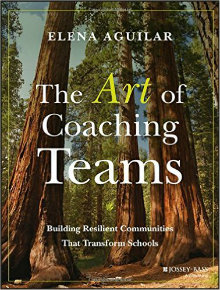The Art and Practice of Coaching Teams
The Art of Coaching Teams: Building Resilient Communities that Transform Schools
By Elena Aguilar
(Jossey-Bass, 2016 – Learn more)

Coaching has become the trend in districts across the country. Yet often the leaders who are asked to do this complicated and important work are paving fresh paths within the systems they coach in.
The Art of Coaching Teams is a readable and practical resource full of Elena Aguilar’s insights and proactive thinking directly from her time in the trenches. The author has worked as a teacher, coach, administrator and consultant within schools for over 20 years. Currently, she consults with districts that are developing coaching programs.

Aguilar makes a case throughout the book that transformational change is the optimal mode to pursue if we are truly attempting to create successful learning environments for students. Her text is a valuable resource for anyone seeking advice on how to build up the people they work with, use meeting time in a meaningful way, and move towards positive change, even in difficult environments.
What you’ll find in the book
The Art of Coaching Teams begins by asking the reader to consider their own vision for teams. The author lays out a definition of effective teams and considers the purpose of forming teams within education. Next, she deals with the coach’s emotional intelligence and awareness of power structures within our system.
Aguilar includes an entire chapter on building trust that offers many practical suggestions and tips. She elaborates on vision and goal statements as well as roles that team members can take on to ensure that work plans and agreements are adhered to.
Setting a high value on norms not only being set but adhered to by the team, Aguilar focuses an entire chapter on setting norms, offering various suggestions on how to proceed through that work, step by step. She includes practical strategies to promote a group’s emotional intelligence as well as a chapter on healthy conversations. One of my favorite tips from this chapter has to do with problems within teams. She advises that when problems or resistance arise, adopting a stance of inquiry as a coach can assist in managing emotions and moving the team forward quickly.
Aguilar also underscores that teams often move into decision making moments without clarity regarding their role, the type of power they have, or that they are making decisions at all. She offers several protocols to follow in this area, noting that the main responsibility of teams is to learn.
The book includes examples of team meeting schedules as well as various outcomes for team meetings. She also discusses the various uses of time within a team meeting – meaning making, discussion, decision making, etc. – and provides various protocols linked to each of these purposes.
One entire chapter of the text is devoted to designing meetings. She walks the coach through collecting feedback, designing an agenda, developing a checklist, preparing to act as the presenter, and completing “finishing touches.”
Navigating conflict and keeping teams healthy
The last couple of chapters are full of practical suggestions on navigating conflict within a team meeting and determining the health of one’s organization. Aguilar finishes by distinguishing healthy conflict from unhealthy conflict and includes sentence stems that can be used during conversations involving conflict.
Since many of us work in situations where the conflict in teams has overflowed into the system, she provides reflective questions and practical suggestions and checklists to consider if the environment we are working in is toxic.
Aguilar argues that a successful coach is one who is reflective, holds positive intentions for their colleagues, and can manage their own emotions. Each chapter begins and ends with examples of team meetings from her own experience that relate directly to that chapter’s concept. I connected to each of the anecdotes as they upped my curiosity to read further into the chapter and learn how the author might coach a team leader in that specific situation.
Many tools for reflection
Each chapter also includes tools for reflection. Within the first chapter, the text asks “What is a great team?” and allows the reader to move through a checklist that identifies the indicators of a great team. I found that the reflection tools assisted me in determining specific goals for the various teams I work with.
While the systems we work for often value projects and performance, Aguilar emphasizes throughout the text that a coach’s role includes slowing down and clearly defining the vision, purpose and goals for our teams. That thinking resonates with me since I am often left wondering whether a meeting has been successful or not.
When I began coaching, I used to think that the difficult people in the room were simply that: difficult. Aguilar includes a range of tips for facilitators from the simple – such as “starting team meetings with five quiet breaths” and “offer people a few minutes to check in with each other” – to the complex, with a list of questions to consider when dealing with an “overtalker.”
This is a valuable, versatile and enjoyable book
Many portions of this text can be used directly with the teams we lead to spark conversation, move through challenges, and reflect. The author also includes specific references to her website where she provides even more tools for the reader.
If you are a first-time coach, you will appreciate Aguilar’s advice about specific issues of leading teams such as agenda setting and the purposes of various meetings. On the other hand, if you are an experienced coach who is leading teams with challenges, you will discover practical suggestions for dealing with gossip and discussing issues of race, gender and class.
This is a text that I thoroughly enjoyed and will return to frequently for advice, coaching, and practical strategies on leading with a focus on trust, clarity and purpose.
Deserie Bradvica is an English Language Arts Specialist. She currently works for the Alhambra Unified School District supporting teachers who work with children in Transitional Kindergarten through Eighth Grade by providing professional development, leading grade level teams, supporting assessment committees and offering demonstration lessons. She is a Fellow of the South Basin Writing Project, a National Board Certified Teacher, and an avid reader.






























